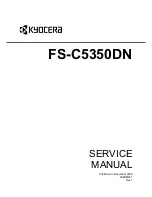
TCP/IP Peer to Peer (LPR) Printing
Verify that the TCP/IP Protocol and Printing Services are installed in the workstation
1.
At the Desktop, right mouse click the
Network Neighborhood
icon and select
Properties
. Click on the
Protocols
tab and verify that the
TCP/IP
protocol has been loaded on the workstation.
Note: If the TCP/IP Protocol is not present in the Protocol list, click the
Add
button, select
TCP/IP
Protocol
from the available list, and click
OK
. If the setup program fails to find the required files, you will
have to click
Have Disk…
to load the protocol from the Operating System installer disk for this
workstation.
2.
After verifying that the TCP/IP Protocol is present, click on
TCP/IP Protocol
to highlight it, and click on
the
Properties
button of the Protocols window. If using Dynamic TCP/IP Addressing, select the radio
button for Obtaining an IP Address Automatically from the DHCP Server. If using Static TCP/IP
Addressing, select the radio button marked Specify an IP Address, and enter in the required IP Address,
Subnet Mask, and Gateway addresses for this workstation. Click
OK
when done.
3.
Select the
Services
tab and verify that
Microsoft TCP/IP Printing
is loaded.
Note: If Microsoft TCP/IP Printing services are NOT loaded, click the
Add
button, select
Microsoft
TCP/IP Printing
from the available list, and click
OK
. If the setup program fails to find the required files,
you will have to click
Have Disk…
to load the service from the Operating System installer disk for this
workstation.
Add the Printer to the Windows NT4 Desktop
1.
From the
Start
menu, select
Settings
and then
Printers
.
2.
Double-click
Add Printer
.
3.
Verify that
My Computer
is selected and click
Next
.
4.
Click
Add Port
.
5.
From the list that appears select
LPR Port
.
6.
Click
New Port
.
7.
Type in the IP address of the Printer for the "Name or address of server providing lpd." Type in the case-
sensitive name of your Printer, or enter in the word
raw
for "Name of printer or print queue on that
server." Select
OK
.
8.
Select
Close
. The Wizard will return you to the previous dialog. Verify the new IP address you entered
is in the list and correct.
9.
The Port check box to the left of the address must be checked. If it is not, check it, then select
Next
.
10.
You will be prompted for a print driver. Select
Have Disk
and browse to the location of your print drivers.
11.
Select the
.INF
file, then click
Open
.
12.
When the "Install from Disk" screen displays, verify that the path and file name are correct and click
OK
.
13.
Select the model that corresponds to your Printer and click
Next
.
14.
At the next dialog, enter a name for your Printer and select either Yes or No for making this printer your
default Windows printer. Select
Yes
if you will be printing primarily to this printer from your Windows
applications. Click
Next
.
15.
Select
Not
Shared
unless the Printer is directly connected to your workstation and you wish to share it
with other network users. Click
Next
.
16.
Select
Yes
to print a Test Page.
17.
Select
Finish
and verify that the Test Page printed out at the Printer.
file:///C|/0-web/boxster/WorkCentreM24-System-Analyst-Guide/Pages/D1_TCPIP_LPR.htm (3 of 5) [9/4/03 8:32:53 AM]
Summary of Contents for WorkCentre M24 Color
Page 2: ...Product Overview WorkCentre M24 Product Overview Standard Features Options...
Page 39: ...Novell NetWare 3 1x Bindery Networks...
Page 52: ...5b1 TCP IP Dynamic Addressing Select another Protocol Go on to Step 6...
Page 60: ...6a1 TCP IP Peer to Peer LPR Printing...
Page 82: ...6a8 EtherTalk AppleTalk Peer to Peer Printing...
Page 96: ...5h1 IPP Configuration Select another Protocol Go on to Step 6...
Page 141: ...Before You Start Click to continue on to POP3 and SMTP Setup...
Page 160: ...Unique Fax settings 18 400 0 50 to 400 50 to 400 range in 1 increments...
Page 219: ...Trademarks Notices Trademarks Notices Trademark Acknowledgements R1 Notices R2 Safety Notes R3...
















































